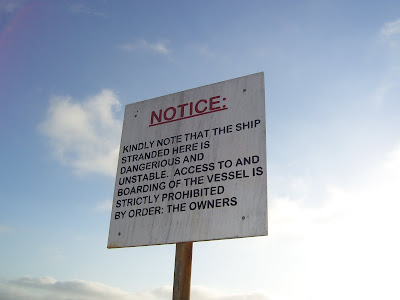

Germany arrived in late in the European competition for slices of southern Africa and left early. You couldn't tell that by visiting Swakopmund, a Namibian beach resort.
The town has a lovely Lutheran church, along with more generic seaside features such as a lighthouse and good restaurants by the beach, all shown above in pictures my husband took.
There's a street named for Kaiser Wilhelm. Medicine sold in the pharmacy has printed instructions in German as well as English, the official language of Namibia. A sign in a shop window advertised a sales job for a speaker of English and German.
Germany's influence seems vastly out of proportion to its short stint here as a colonial power. Germany grabbed much of what is now Namibia in the late 19th century, about 400 years after the Portuguese visited and found little worth keeping.
The Namibian coast is particularly treacherous. Shipwrecks continue into modern times. This one happened perhaps five miles from Swakopmund.


The sailors from this boat would have been easily able to walk to civilization once they reached the shore. Most sailors in history have not been so lucky. This is what lines much of the Namibian shore, known partly as the Skeleton Coast.



Germany seems to have taken the land leftover after centuries of battles among the English, Portuguese and Dutch. When Germany lost control of the colony in World War I, the recently created nation of South Africa was given command of the territory.
Different Century
Namibia today is one of the world's most attractive places for travel. Tastes and technologies have changed. The desert's become a place for relaxing drives. Gas stations sell food and water, or at least snacks and soda, along with fuel.
Pick up a rental car at the national capital of Windhoek and it's a nice straight road to Swakopmund. Its scenery is easily the equal of the American West or Australian Outback.
Namibia is known for its relentlessly clear skies. The heavens above its hills and mountains look like the white-cloud-on-blue-sky opening shot of "The Simpsons." This is the kind of drive that both clears your mind and gets you thinking.
Hotel on Bismarck Street
When we reached Swakopmund, we stayed at the Hotel Rapmund on Bismarck Street, pictured below. It was a pretty place right near the water, which cost about $60 for a double room, according to David's notes.

The Rapmund's breakfast spread was ridiculously good. Its buffet table included cheeses, cereal and liverwurst. Baskets of fresh bread lined one end of the table. Among the the chunky jams available was a heavily gingered melon, which I will remembered for a long time.
We filled our plates with little--and big -- tastes of everything and took a table for two by the window. The dining room manager appeared as soon as we sat down, bringing coffee and steamed milk for David and a pot of tea for me.
"How do you want your eggs?" she asked. "Do you want bacon?"
One egg, poached, for me. And, I passed the accompanying bacon strips to David, who reported them to be smoky and delicious. A girl has to have some limits...and there was a fig preserve on the buffet that looked worth a tiny taste.
Woven In
We were the only guests in the breakfast room who spoke English to each other. A friendly group of about six would greet us in English and then return to talking among themselves in a soft and fluid German.
Most of the tourists we saw in our Namibian travels were from Germany. Members of a German colony also had continued living in what's now Namibia after their country lost its grip on the territory. A Lutheran chapel was built in the middle of the 2Oth century in the middle-of-nowhere Namibia, Solitaıre, a town some hours of desert driving from the capitol and the coast.

Among the German colony that stayed on ın Namibia was someone who realized that the prized Karakul sheep of Central Asıa would thrive in the hot and dry southwestern Afrıca country. An article in the magazine of the Namibian airline that outlined how the karakul sheep were brought to the country and thıs led to the creatıon of a new tradıtıon ın makıng rugs. Our hotel had some of these. There were sımple carpets ın beautiful colors on the floors ın the rooms and one hangıng on a wall near the receptıon area that had a beautıful dısplay of anımals woven ın. I would lıke to buy one ıf we are lucky enough to return to Namibıa. They are largely Afrıcan art wıth some of Europe's best tradıtıons mıxed ın, not unlıke Namıbıa ıtself.




No comments:
Post a Comment